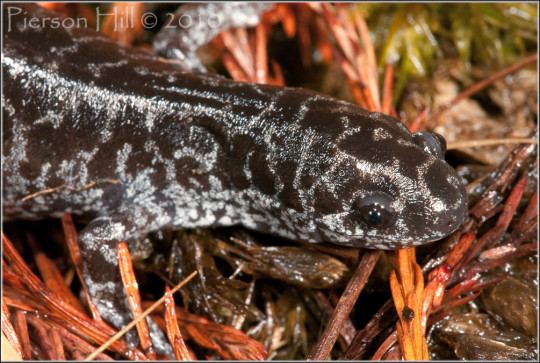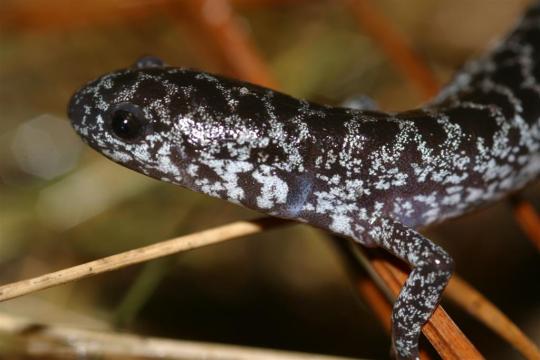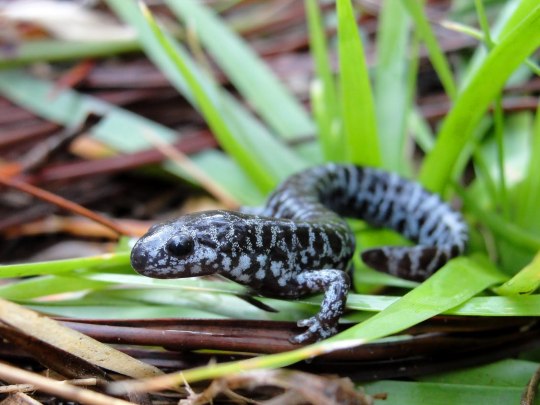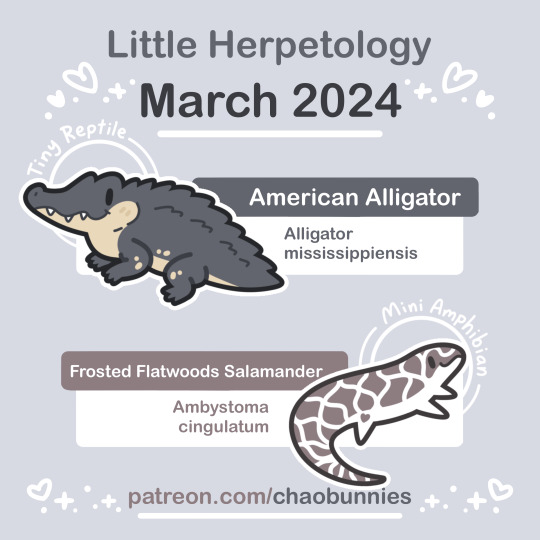#frosted flatwoods salamander
Text


March Tiny Reptile and Mini Amphibian pin previews: American Alligator and Frosted Flatwoods Salamander! 🐊
They're available as pins and stickers until the end of February through my Patreon and will be sent out in March!
#alligator#salamander#herpetology#american alligator#frosted flatwoods salamander#pin club#patreon pin club#enamel pins
90 notes
·
View notes
Text

#memes#ambystoma#frosted flatwoods salamander#ambystomid#salamander#animals#biology#funny#herpetology
413 notes
·
View notes
Photo

Frosted flatwoods salamander sticker
I saw this guy while I was trawling tumblr and decided he needed to be a sticker.
Available here: https://ko-fi.com/s/5d10af45f2
[ID: A sticker depicting a frosted flatwoods salamander, a blue salamander with black spots. The salamander is curled into a circle; the sticker is displayed against ivory faux fur. /ID]
Posted using PostyBirb
3 notes
·
View notes
Text
A job I was applying for mentioned I would be working with something called a “frosted flatwoods salamander”, which sounded positively delightful, so I looked them up and I could not be more pleased with what this beast looks like

87K notes
·
View notes
Text
POP QUIZ
How well do my followers know me? Let’s find out!
5 notes
·
View notes
Photo










The reticulated flatwoods salamander (Ambystoma bishopi ) is a species of mole salamander, an amphibian in the family Ambystomatidae. The species is native to a small portion of the southeastern coastal plain of the United States in the western panhandle of Florida and extreme southwestern Georgia. Its ecology and life history are nearly identical to its sister species, the frosted flatwoods salamander (A. cingulatum). Like the frosted flatwoods salamander, the reticulated flatwoods salamander breeds in ephemeral wetlands with extensive emergent vegetation, probably maintained by summer fires.
Ambystoma bishopi is a medium-sized species with a snout to vent length of 1.6 to 2.0 inches and 14 to 16 costal grooves. The head is long with a tapered snout and there are vomerine teeth in the roof of the mouth. The forelimbs are stout and the tail is flattened towards the tip, being shorter than the head and body length combined. The skin is smooth and the dorsal surface is reticulated, with thin grey lines forming a net-like pattern on a brownish-black background. The ventral surface is dark with sparse white speckles. This salamander is similar in appearance to Ambystoma cingulatum but the latter has a more frosted dorsal pattern and larger white spots on the ventral surface.
Ambystoma bishopi is a burrowing species of salamander and lives among the leaf litter beneath longleaf pine and wiregrass in the flatwoods coastal plain ecosystems of the Southeastern United States. A. bishopi inhabits seasonally wet pine flatwoods and pine savannas west of the Apalachicola River-Flint River system. Wetlands overgrown with woody shrubs are less likely to support breeding populations.
A. bishopi was described in 1950 and received endangered status by the United States Fish and Wildlife Service in 2008.The IUCN lists Ambystoma bishopi as being "vulnerable". This is because the population trend is downward, as a result of habitat destruction and an increase in undergrowth.
[1] [2] [3] [4] [5] [6] [7] [8] [9] [10]
#ambystoma bishopi#reticulated flatwoods salamander#mole salamander#frosted flatwoods salamander#A. cingulatum#endangered species#dinosaurs#amphibian august
115 notes
·
View notes
Photo

Frosted Flatwoods Salamander
The federally-threatened frosted flatwoods salamander (Ambystoma cingulatum) is a long and slender salamander that occurs in the Florida Panhandle eastward of the Apalachicola River and in the northern counties of the peninsula.
The species has sharply declined in recent years, and the very few remaining breeding ponds are in poor condition. Flatwoods salamander breeding ponds were historically maintained by early summer lightning fires that burned through the pond basins when they were dry, but modern prescribed fire practices favor burning under unnaturally cool and wet conditions.
The result is that fire is excluded from salamander breeding habitats, allowing shrubs and dead leaves to accumulate and shade out the grasses and herbs that salamanders require for their eggs and larvae.
Photograph by Pierson Hill/FWC
via: FWC Fish and Wildlife Research Institute
#threatened#salamander#amphibian#herpetology#conservation#environment#north america#florida#animals#nature
136 notes
·
View notes
Photo


it’s been a minute since i’ve had a chance to do more of this endangered animals series!! these are two endangered animals that i’ve been lucky enough to see in real life, the frosted flatwoods salamander (Ambystoma cingulatum) and alligator snapping turtle (Macrochelys temminckii)!! i want to do way more posca pieces, they’re really fun to me 💛
instagram // twitter
72 notes
·
View notes
Text

may I offer you a frosted flatwoods salamander in these trying times (but please only to look and not touch because they are a threatened species as, again, these are trying times) (source)
11 notes
·
View notes
Link

Excerpt from this press release from the Center for Biological Diversity:
The Center for Biological Diversity and Healthy Gulf today filed a formal notice of intent to sue the Trump administration for failing to develop recovery plans for the endangered reticulated and frosted flatwoods salamanders.
Despite the U.S. Fish and Wildlife Service’s promise, in an informal agreement with the Center and Healthy Gulf, to produce recovery plans by June 2019, the Service has yet to develop the legally required plans to save these salamanders from extinction.
“It’s appalling that the Fish and Wildlife Service has dragged its feet on completing recovery plans for these beautiful, highly endangered flatwoods salamanders,” said Jenny Loda, a Center biologist and attorney dedicated to protecting rare amphibians and reptiles. “Without concrete recovery plans, these species won’t survive.”
Reticulated and frosted flatwoods salamanders were historically found throughout the once-extensive longleaf pine forests of the coastal plain in Alabama, Florida, South Carolina and Georgia. But today they’re limited to a handful of small populations in the latter three states. Habitat destruction and poor forest management continue to drive them toward extinction. They are also threated by climate change, which is creating stronger storms in the Gulf of Mexico.
Frosted flatwoods salamander populations suffered significant losses in 2018 when Hurricane Michael, a Category 5 storm, pushed 10 feet of seawater across the St. Marks National Wildlife Refuge in Florida, once considered a stronghold for the species.
“Flatwoods salamanders have continued to decline since their listing more than two decades ago,” said Cynthia Sarthou, executive director of Healthy Gulf. “Developing recovery plans will help ensure that we’re doing everything we can to keep these salamanders from vanishing.”
3 notes
·
View notes
Text

March's Tiny Reptile and Mini Amphibian designs: American Alligator and Frosted Flatwoods Salamander! 🐊
These pins and stickers are available this month through my Patreon and will ship in March!
#reptile#amphibian#alligator#salamander#frosted flatwoods salamander#herpetology#patreon pin club#enamel pins#stickers#artists on tumblr
128 notes
·
View notes
Photo

#StayFrosty Frosted Flatwoods Salamander 𝘼𝙢𝙗𝙮𝙨𝙩𝙤𝙢𝙖 𝙘𝙞𝙣𝙜𝙪𝙡𝙖𝙩𝙪𝙢 A glorious chonkin specimen from the salamander lab at AF. This is an adult reared from larvae collected from Fort Stewart, Liberty County, GA. (at The Amphibian Foundation) https://www.instagram.com/p/B-Ka1wohe1l/?igshid=1ron3q2baphis
4 notes
·
View notes
Text
Warfighting And Biomimicry in the 21st Century
How Does An Army Bombing Range Support Conservation And Protection Of Endangered Species?
Contrary to conventional thinking, the military and conservation efforts are not diametrically opposed. In fact, if we dive beneath surface-level assumptions that the military does not possess sustainable mindset, we will unravel a very different story.
In the United States, military land totals roughly 25 million acres. These are lands that are protected from commercial development and support numerous biomes. Often, these lands are considered to be rare, unique, and — typically — have endangered flora and fauna. Once the 1960 Sikes Act was signed into law, the value of the natural resources on these lands were officially recognized. Subsequently, mandates from the Secretary of Defense followed suit, specifically for the implementation of programs that “[provided] for the conservation and rehabilitation of natural resources on military installations.”
Further, the Sikes Act requires that the installation commanders are to create a comprehensive plan to manage natural resources effectively. Then, in 1997, the Sike Act Improvement Act broadened the scope of natural resource management to provide for the following: more funding, greater scientific research, and greater civilian oversight of existing environmental programs.
Did This Law Work?
Welcome to Townsend, Georgia the home of the Townsend Bombing Range that is ‘owned’ by the U.S. Marine Corps, but used by all branches of the military. Near this forty-mile, coastal strip of land is a ‘wildlife greenway’. Or, in other words, a corridor for conservation that actively works to reduce habitat fragmentation by keeping wildlife zones connected.
Since the 1960 and 1997 Sikes Act and Sikes Act Amendments, respectively, the Department of Defense has contributed $26 million to the $93 million project. The funds are used to prevent developers from breaking up these fertile areas into commercial or residential properties. Further, the Marine’s land management program is actively working to not only bring the frosted flatwood salamander back from the brink of extinction, but to also expand livable areas for the endangered red-cockaded woodpeckers and to protect the water quality in the vicinity of the bombing range. These efforts highlight the positive role the military plays in conservation and sustainability efforts.
Why Are Environmentally Responsible Policies In The Best Interest Of The Military?
Since natural resources are used widely at military installations, there is an inherent national security necessity to protect and sustain. For instance, at the U.S. Air Force Academy, a 6 megawatt solar array was installed with the ultimate goal of generating 100% of the base’s electricity on-site. This example addresses the environmental need to be decrease reliance on coal and also serves a fundamental function of government to provide value to taxpayers. Another example is the development of pulse technology by the Army. This pulse technology increases the life lead-acid batteries by 80% — a remarkable feat. Not only does the increased life of the battery reduce toxic waste from entering the environment as quickly, but it also significantly reduces costs for taxpayers and extends the product lifetimes for the Army.
Another reason for the military to promote sustainability is the availability of unique biomes for training. The Army’s 10th Mountain Division based in Fort Drum, NY, is focused on warfighting in mountainous and arctic conditions. It is also home of the Sustainability Expo that brings together military and contracting personnel with sustainable vendors and innovators. Conservation and sustainability are critical to the Division because of their unique need to mimic the undeveloped mountainous terrain and snowy conditions that soldiers would experience abroad. Simply put, this training environment cannot exist without habitat protection and comprehensive sustainability planning.
Parting Thoughts
Not only are environmental stewardship and sustainable practices in the best interest of the Armed Forces, but the military has aligned their interests with conservation efforts. To be an effective warfighting force in the 21st century, it is critical for military members and all of society to recognize the need for environmental action and its impact on national security and natural resources critical to the military’s mission and success.
#biome#biomes#bio#mimicry#biomimicry#warfighting#army#1960 Sikes Act#1960 Sikes Act Amendment Act#million acres#protected lands#commercial development#1997 Sikes Act Improvement Act#natural resource management#frosted flatwood salamander#red-cockaded woodpecker#bombing range#pulse technology#Army's 10th Mountain Division#Fort Drum#New York#Sustainability Expo#Armed Forces#Environmental Stewardship#Sustainable Practices
0 notes
Photo

Frosted Flatwoods Salamander
This photo of the Federally Threatened Frosted Flatwoods Salamander (Ambystoma cingulatum) shows this animal at an advanced larval stage.
The adults look very different! It was found in the St. Marks National Wildlife Refuge in Florida. Historically, scattered populations occurred in restricted habitats in South Carolina, Georgia, Florida, and Alabama. However, this species has not been found in Alabama since the early 1970s.
This animal was captured under a permit issued to the U.S. Geological Survey by the U.S. Fish and Wildlife Service. It was photographed and released unharmed.
Photo credit: Alan Cressler (acressler on Flickr)
via: U.S. Geological Survey
90 notes
·
View notes